|
|
|
 |
 |
 |
|
Category: theology
|

|
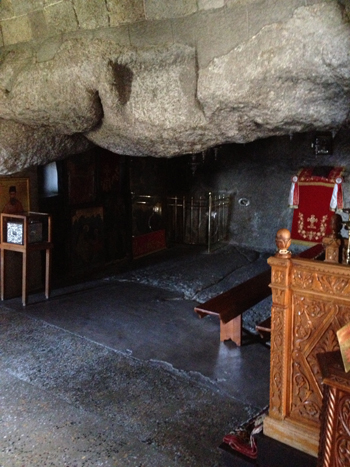
|
 |
Heaven open on Holy Patmos
Posted on 02 May 2013, 3:49
Seven churches: Intro Pergamum Thyatira Smyrna Laodicea Philadelphia Sardis Ephesus Patmos
My sets of pics for this post: Patmos
Leaning against the ferry rail, the black water of the Aegean slid past below me, lit by the full moon high above. I saw dimly a small island shaped like a flat pyramid, darkly mysterious, as we sailed past. I leaned out and far ahead in the night were tiny lights – the lights of houses on the island of Patmos. It was 37 minutes past midnight and the words of John’s Apocalypse came into my head…
After this I looked, and, behold, a door was opened in heaven: and the first voice which I heard was as it were of a trumpet talking with me; which said, Come up hither, and I will show thee things which must be hereafter. And immediately I was in the spirit…
John, the author of the letters to the seven churches, was exiled here for his faith in the 1st century, and now, 2,000 years later, my father and I were arriving to complete our journey to this place where heaven was opened.
After our boat docked, we walked through sleeping streets pulling our cases on wheels. The hotel reception was closed, but five keys were on the counter with names sellotaped to them… none of them ours. So we took two at random and bedded down for the night.
I woke after an hour or two from a dream in which hundreds of people were walking up the street to our hotel, dragging their cases, the hundreds of rolling wheels filling the island with a great roaring noise, and all the people inexorably marching to claim the room they had booked and I had stolen.
Awake in the dark, it felt like a updated scene from the Revelation, with the Beast and the Whore of Babylon checking in their luggage. This island has something spookily spiritual about it.
Next morning, we walked down to the port town, Skala, which curls around a bay lapped by deep, transparent blue water. The sun was shining madly.
The town is all restaurants patrolled by cats, craft shops stocked with sponges and shells, narrow streets revealing whitewashed, domed churches, Greek men hurtling by on motorbikes, Orthodox priests flapping or pausing to pinch the cheek of a child, shop windows full of icons, fruit sellers at the harbour, men busy doing nothing at a taxi rank.
Over coffee at a streetside café we got talking to the owner and complimented him on the island. ‘It’s a beautiful place,’ I told him.
‘Yes,’ he agreed. And then with hardly a hint of smile: ‘But it is also a holy place.’
High over the town on a hill is the Monastery of St John the Theologian. Late morning a taxi bore us up a winding road through pine trees, past a stonemason’s yard with signs outside advertising petra and marmara (stone and marble), until we reached the Cave of the Apocalypse, below the monastery.
This is where the exiled St John received his Apocalypse, according to local tradition. And it is where our seven churches pilgrimage was completed.
It is 40 steep steps down to the cave and my father is 85, but he’s also intrepid and we made it down arm in arm almost without a pause. Over the doorway before you enter the cave is a bright icon of St John in red robes holding a pen in one hand while a pen holder is under his other arm. The book he holds is open at a page full of Greek text which reads: ‘In the beginning was the word…’
We stepped through the doorway and into the place where that word was alarmingly revealed. Although an Orthodox chapel has been added to the front of the cave, the powerful forms of the bare rock on your right are what immediately command your attention. The entrance to the cave is low, while the roof rises behind it, reminding me of a huge fireplace, which seems right. Holy fire touched down here.
In a deep recess is a place of prayer, marked by red velvet draped over the rock and hanging silver oil lamps above. The cave reminds me of the prophet Elijah in the Old Testament, who stood in the mouth of another cave and experienced earthquake, wind and fire, but found God instead in a still small voice. St John’s writhing visions seem to be the reverse of Elijah. They have nothing of the still small voice, but all of the earthquake, wind and fire.
And yet the atmosphere in the cave was quiet and expectant. We were there entirely on our own, which I think must be quite unusual.
A small window shows the view from the mouth of the cave. Below are the trees, fields, hills and bays of Patmos, and then the sea, and then the eastern sky. As he sat here, St John looked out towards the faraway seven churches of Asia Minor.
I sat with my father on a wooden bench and we prayed together. The cave has a beautiful acoustic. It is a place where the door of heaven opened for St John like the door of a furnace. In a small way, it opened for us too, but breathed only peace at the end of a journey.
Comment (0) |
 |
|
|
 |

|
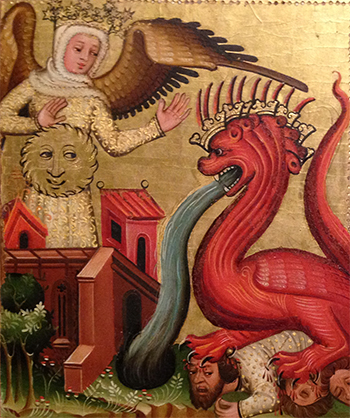
|
 |
Off to the Apocalypse
Posted on 20 April 2013, 3:41
Seven churches: Intro Pergamum Thyatira Smyrna Laodicea Philadelphia Sardis Ephesus Patmos
Early tomorrow morning, my father and I fly to Izmir in western Turkey for a week rediscovering the seven churches of the Apocalypse. We travelled together last year to Germany, visiting the towns where JS Bach lived in the 18th century, but this time we’re going back to the world of 1st century Asia Minor, to the roots of his faith and mine.
Aside from having our hearts strangely warmed, the temperatures are going to be in the mid-20s (or mid-70s in the old currency) and it’s going to be good sitting outside for seafood and wine after so many months of winter.
The Apocalypse, better known as the book of Revelation, was written on the Greek island of Patmos. It opens with a series of mini letters – almost postcard in length – written to seven churches on the mainland of what is now Turkey. The letters are colourful and strongly worded, with a mixture of praise and promise, criticism and warning for each church.
We’re going to be visiting each of the seven towns (most of which are in ruins) and then sailing to Patmos for the final couple of days. John the Divine, the author of the book, was exiled here for his faith in the 1st century, and a highlight will be visiting the Patmos cave where it’s believed he received his visions and prophecies.
The Apocalypse was a book which almost didn’t make it into the New Testament because of its bizarre and nightmarish content. It has choirs of saints and angels, beasts with multiple heads and on each head a crown, a pitched battle between the forces of light and darkness, a smouldering lake of fire for the wicked and paradise regained for the righteous.
The Eastern Orthodox still won’t allow the book to be read aloud in church for fear of its horrors and mysteries upsetting the faithful. This is probably wise.
I visited the Victoria and Albert Museum in January and spent time looking at a vast 14th century triptych they have from Hamburg. It’s covered with scenes taken from the Apocalypse, and I snapped one of them, seen above. It gives an idea of the dense and fevered atmosphere of the book.
Will Self, in his combative introduction to a pocket edition of Revelation in the King James Version, says he found it ‘a sick text… a guignol of tedium, a portentous horror film.’
Aside from all that, I’m looking forward to immersing my head into the world which gave birth to the Jesus movement in the 1st century. Towns such as Ephesus are really familiar to me from reading the book of Acts, and the idea of actually walking those ancient streets is intoxicating. I’m hoping to blog about the experience day by day, so long as the bandwidth of Asia Minor holds up.
Comment (1) |
 |
|
|
 |

|
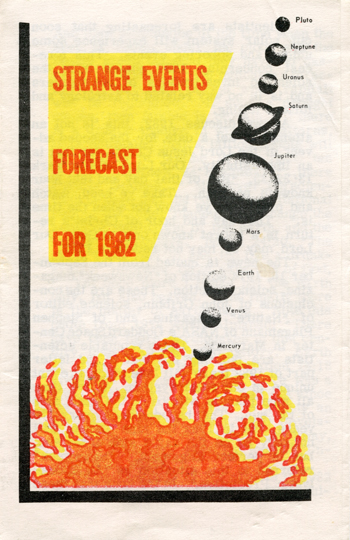
|
 |
The vanity of comets
Posted on 15 February 2013, 18:03
Today sees the rooftop-rattling flyby of asteroid 2012 DA14, a 50-metre chunk of space rock half the size of a football pitch. At 7.24pm (UK time) it’s going to miss hitting Earth by just over 17,000 miles, 5,000 miles closer than the SatNav satellites.
To get an idea of why it’s a good thing not to have an asteroid smacking into your planet, a rock the same size gouged out the mile-wide Baringer Crater in Arizona when it dropped from the sky 50,000 years ago, and another exploded in the air over Tunguska, Siberia, in 1908, flattening 80 million trees in a blast thought to be 1,000 times more powerful than Hiroshima.
Collision with asteroids is a popular form of apocalypse these days, along with zombie attack, neither of which feature very much in the Bible’s versions of Last Things. The 1998 movie Deep Impact, for example, had a 7 mile wide comet steering for Earth to trigger an ‘extinction-level event’.
Talking of comets, the heavens won’t be finished with us when 2012 DA14 flies back off into space tonight. That’s because the comet ISON is set to skim the sun on 28 November.
ISON is currently being touted as a once-in-a-civilisation sort of comet. ‘The comet could outshine the moon,’ muses Brian Cox in The Sun (that noted journal of heavenly bodies), ‘with a spectacular tail sweeping across the night sky.’
Back in 1974 when I was a teenager, I was severely ticked off by comet Kohoutek, which was similarly hyped up but turned out to be a dud. This has given me a lifelong suspicion of the vanity of comets.
The soothsayers of fundamentalism are already pitching ISON as Jesus’s very own firework display in celebration of the second coming. It’s a bizarre meeting of astrology and theology.
WND Faith lists the comet as a ‘celestial sign of things to come’ and links it to four total eclipses of the moon, which are apparently set to happen in 2014 and 15. It’s during one of those eclipses that ‘the Second Coming of Christ will likely occur’. I hope Harold Camping is taking notes as he reads this.
Meanwhile, over on the somewhat excitable Above Top Secret website, the comet will be just one event in the Great Tribulation described in the book of Revelation. The website gives us the schedule: ‘Nov. 16, 2013 kicks off Trumpet 5 and starts the 1st woe. Comet ISON is scheduled for an appearance at this time – this is the false “sign of the son of man in heaven”.’
Comets have been seen from pre-history as terrifying signs of impending change and disaster. Along with eclipses, they pointed to the deaths of kings, the outbreak of plagues or the coming day of doom. They caused fear and panic in the mouths of caves when we still lived in them, and later on the streets of ancient cities from China to Babylon to Rome.
These visceral beliefs were reinterpreted by monotheism as the righteous judgments of God. Because comets disrupt the regularity of the heavens, they must come from the hand of God as portents of disaster on Earth. They’re especially at home in apocalyptic writings – as brought to us by Isaiah, Ezekiel, Joel, the book of Revelation and Jesus himself. Apocalyptic stocks its horror shows with falling stars, blood-red moons, fire from heaven, brimstone falling into the sea, the sun extinguished.
I’ve kept hold of a wonderful tract I found in the late 1970s about the line-up of the planets which took place in 1982 (pictured above). After predicting that the conjunction could cause storms on the sun, earthquakes on earth and even (shudder) disruption to TV programmes, the tract urged the following message on its readers:
‘All this means that the coming of the Lord is drawing very near. By 1982 our world could be feeling the wrath of God in the coming time of tribulation.’
The second coming – that most sci-fi of all Christian beliefs – did not happen on the strength of lined-up planets in 1982. And Jesus will not return riding on comet ISON (like the final scene in Dr Strangelove) in 2013. But that won’t stop Christians from co-opting comets and asteroids into their dark fantasies of doom for the next few months.
Comment (3) |
 |
|
|
 |

|
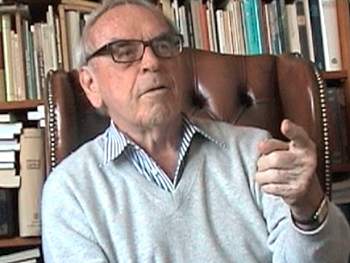
|
 |
90 minutes with Moltmann
Posted on 14 March 2012, 6:21
Jürgen Moltmann has a very infectious way of laughing. He fixes you with his bright eyes, a smile spreads across his face as he’s talking, and then comes the almost soundless laughter that sweeps you with it. I really hadn’t expected that from one of the 20th century’s most brilliant German theologians, and even less so from someone who powerfully made the case, after Auschwitz, that God is a God who suffers.
I visited him at his home in Tübingen last week, after a 10 hour train journey. The magazine which sent me to interview him, Third Way, didn’t want me to fly by plane, for the greenest of reasons, but it was a long journey to make for a 90 minute meeting. It turned out to be beyond rewarding, though.
The French and then German countryside unfolding outside my train window was beautiful in the early spring sunshine, but I had my head stuck in a book most of the way. Like an undergraduate with a late essay to submit, I was deeply into Moltmann’s brick-sized autobiography, A Broad Place (408 pages), which turned out to be an inspiring read. By the time I sank into my hotel bed at 2am, I was ready with my list of questions.
Professor Moltmann retired in 1994, but since then, six new books of his have been published in English, with a seventh currently in the works. He’s now 85, but several years ago when he turned 60, he said that he unexpectedly ‘became young and lively again’. His youthfulness in old age seems to have stuck. The first sign I saw of it came after I climbed the road up and out of old Tübingen, along the valley above the River Neckar, and found that the car parked outside his house had personalised number plates. I spotted the ‘JM’ straight away.
Inside, after he’d made me a dish of very weak tea (I estimate Pantone 726), he took me into his study, which is a broad, beautiful, light-filled room looking down the steep slope of his long garden into the valley. I always enjoy seeing where people work, and this room, where so much influential thinking took shape, was everything you could wish for.
With no computer in sight, I asked him if he used an Apple Mac. ‘I am an old European,’ he replied, amused at himself. ‘I use telephone and fax.’ He writes his books by hand and corrects a typewritten copy. ‘I like the combination of mind and hand,’ he said, and then added, ‘At my age, I am writing more letters of grief and consolation, and I cannot type a letter of compassion.’
I’d asked to see his study because I wanted to know what pictures he had in there, as some of his thinking has been shaped by meditating on images such as Andrei Rublev’s icon of the Holy Trinity. He showed me a Greek icon of the resurrection on the wall, as well as a postcard image of Marc Chagall’s Yellow Crucifixion, which he had tucked inside a first edition of his book The Crucified God.
‘For a long time this picture was my companion,’ Moltmann wrote in his autobiography, ‘and was a symbol inviting me to theological thinking.’ I don’t know of many Western theologians who have done this.
At the end of our 90 minutes, I had to dash to catch my train home, but as I was packing up I couldn’t resist asking him what his favourite hymn was. It’s a bit of a cheesy Songs of Praise question, but I was interested in what a theologian would do with it. When he hesitated to answer, I expanded the question by asking what are his sources of inspiration and consolation.
‘Mostly watching nature – and especially the sea. From Hamburg, we always spent our holidays at the seaside. I was always fascinated and had mystical experiences! The music of the sea is like the tone of eternity. Because this was here before human beings came and this will be there when human beings have maybe vanished from the earth.’
I shot a video of the interview and will be putting some clips from it online soon. I’ll post here when they’re up.
Comment (1) |
 |
|
|
 |

|

|
 |
Interview with a theologian
Posted on 02 March 2012, 6:19
It’s not every day you get to meet a 24 carat theologian, but next week I’m doing just that. I’m off to Tübingen in Germany to interview Jürgen Moltmann, who’s up there with Bonhoeffer, Barth, Bultmann and the other pin-ups of 20th century theology. The interview is for Third Way magazine, but some of the interview will be published on Ship of Fools and here.
Moltmann is probably most famous for his books Theology of Hope and The Crucified God, published in 1964 and 1972. But the things which have caught my eye so far in preparing for the interview are his experiences during and after the Second World War, where he fought as a soldier in the German army.
In his autobiography, A Broad Place, which I’m currently devouring, he says that he had no Christian faith then, but after he was captured by allied troops and held in a POW camp in Scotland, he started to read the Bible soon after he and his fellow POWs learned the terrible truth of what had been happening in Belsen, Buchenwald and the other concentration camps. ‘For me,’ he says, ‘every patriotic feeling for Germany – “holy Fatherland” – collapsed and died.’
In the early 60s, he travelled to Poland for the first time. He writes…
|
 |
 |
 |
 |
 |
| |
The most deeply emotional experience was to walk through the Maidaneck concentration and death camp, near Lublin. The plank beds in the barracks were the last resting places of starving and tormented men, women and children. Behind glass lay the little shoes of the murdered Jewish children, and hair that had been cut off from the gassed women. We saw the pits in which more than 10,000 people had been shot on a single day.
At the time I wanted to sink into the ground for shame, and would have suffocated in the presence of the mass murder, if on one of the roads through the camp I had not suddenly had a vision. I looked into the world of the resurrection and saw all these dead men, women and children coming towards me. Since then I have known that God’s history with Auschwitz and Maidaneck has not been broken off, but that it goes further with the victims and with the perpetrators. Without hope for the ‘new earth in which righteousness dwells’ (2 Peter 3.13), this earth, which has suffered Treblinka and Maidaneck, would be unendurable.
|
|
 |
|
 |
|
The experience profoundly shaped Moltmann’s theology in the 60s and 70s, which on one level responds to the question, How can you speak about God after the Holocaust? Where was God in the midst of that unimaginable suffering? His striking vision of ‘looking into the world of the resurrection’ is a pointer towards his theology of hope, where the kingdom of God breaks into the present from the future.
I’m hugely looking forward to meeting and talking with Jürgen Moltmann. If any readers of this blog would like to suggest questions to ask him, please post them here.
|
|
Comment (1) |
 |
|
|
 |

|
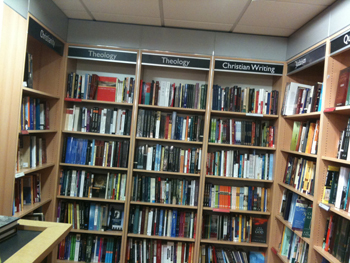
|
 |
Epiphany in a bookshop
Posted on 27 January 2012, 4:42
I was in Foyles (the bookshop equivalent of the Tower of Babel, so endless and towering is its collection of books) on Charing Cross Road the other day. I was looking for a good introduction to the Christian faith and was trying to steer clear of Mere Christianity.
No offence to CS Lewis, of course, but I find MC is dating quite badly. It’s sounding more and more like the voice of a great uncle who wears tweed suits and flannel underpants, smells of mothballs and tobacco and talks like a BBC newsreel. It’s not its own fault, poor thing – parts of the book date back to 1941. But surely someone’s written a classic intro to the faith which has the smell of today and can topple MC from its top spot on the Christian bookshelf?
Anyway, standing on the second floor, surrounded by enticing books on New York, Turkish cooking, hitchhiking in Patagonia, how the human eye works, London’s lost rivers, lives of Dickens – not to mention the miles of shelves devoted to novelists from Ackroyd to Zafón and back again, I noticed that the few shelves of the Christianity section have been shoved into an obscure corner, sandwiched between the paranormal and psychology.
As I struggled to find an alternative to CS Lewis, the weight of a million brilliant modern books pressed in on me and made me see in a new way how small, how pushed into a corner, how seemingly backward-looking and irrelevant my faith is.
I realised that if I wanted to buy a world class book, either because it was beautifully written, or groundbeaking in its ideas, or sharp in its take on life, or because it contained the best comedy or tragedy or sheer storytelling money could buy, then I would not find it here, in Kristianity Korner.
That in turn made me think how few of the people I really admire in mainstream culture – people who make me laugh, people who challenge me to think better, people who show me the world in a new way through books, films or TV programmes – how few of them have anything but scorn or apathy for religion.
Frank Skinner recently told Rowan Williams that many standup comics today, even if they have no particular gripe against God, will take a few minutes out of their set to say how hilariously awful religion is and how atheism is the answer. I’ve had to accept the marginalisation of my faith ever since I became a Christian, but somehow, standing there on the second floor of Foyles, it crashed in on me in a new way.
Christians who want to live their chosen faith wholeheartedly, but who want to live in our culture wholeheartedly too, have the Devil’s own choice if they think about it long enough. In my experience, we mostly duck the issue and get on with the practical business of standing by the faith choice we made a long time ago. But it’s painful whenever you do think about it, because the pressure of faith and the counter-pressure of culture act like a pair of pincers on the soul.
How do we respond to the spiritual pain of that? A widespread response among believers is to create bubbles within the culture where we can do our own little thing and pretend that nothing outside the bubble is truly important.
There are bubbles where Christians fantasise about revival or the second coming or the blessed return to Latin liturgy. There’s the bubble of church itself, of course, with its essentially medieval world of sermons, processions, reciting texts together in buildings with pointy windows, dressing up in clothes the Romans would feel at home in, and lighting candles in the age of the electric light.
It’s lovely, but it’s a lovely bubble, a little culture inside a bigger culture with less and less appeal to the world as it is out there. These rejections of the wider world are ways of turning aside the pain, of relieving the pressure which bears down so sharply on people of faith.
Another response is gradually losing your religion because it’s too hard to sustain, or because you finally need to call time on a faith which no longer has any immediate hold on your imagination. Matthew Arnold’s poem, Dover Beach, becomes a personal experience as the sea of faith makes its ‘melancholy, long, withdrawing roar’.
I’ve always been something of a fan of the friction between faith and culture. I’ve believed it can be a creative, self-critical force, demanding the best from us in making the connection between God and the world of here and now. But I don’t see that friction producing bright sparks in huge quantities among Christians today. I don’t see much creative impact on the mainstream as I stand on the second floor of Foyles receiving my negative epiphany.
In the end, I ran out of time and bought Screwtape. At least it wasn’t Mere Christianity, but it was the very next book on the narrow shelf.
Comment (14) |
 |
|
|
 |

|
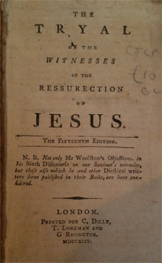
|
 |
The resurrection goes to court
Posted on 16 September 2011, 18:39
I was in the basement of Quinto’s second-hand bookshop on Charing Cross Road the other day and came across a slim, battered volume from the 18th century with the gloriously misspelled title, The Tryal of the Witnesses of the Ressurection of Jesus, by Thomas Sherlock.
The cover was falling off, but in the musty pages I was surprised to find a little work of fiction which presents the case for the resurrection as a courtroom drama. The story is that a group of m’learned friends fall into a conversation about the resurrection, and agree to stage a trial for their own entertainment. When they next meet, their project has drawn a small crowd, so they elect a judge and jury and start to interrogate the accounts of the key witnesses in the four gospels.
The book concludes with the judge asking the jury, ‘Are the apostles guilty of giving false evidence in the case of the resurrection of Jesus, or not guilty?’ To no great surprise, the verdict of the jury is ‘not guilty’.
This copy of The Tryal of the Witnesses was published in 1794, the year The Terror ended in France. I was intrigued by its age, because the standout book for me arguing the resurrection forensically is Frank Morison’s celebrated Who Moved the Stone? which was first published in 1930 but has been in print ever since. That book was written by an English advertising exec (real name, Albert Henry Ross) whose ad agency also employed the novelist Dorothy Sayers as a copywriter and whose greatest success was the ‘Guinness is good for you’ campaign.
Morison borrows the language of the courtroom in examining the death and resurrection of Jesus, with breathless chapter titles such as, ‘The real case against the prisoner’, ‘The situation on Friday afternoon’ and ‘The evidence of the principal fisherman’. Thinking about it, those headlines sound more like the work of a tabloid hack scribbling at the back of the courtroom than a learned barrister.
Despite that (or maybe because of it) Who Moved the Stone? remains a classic on both sides of the Pond partly because Morison started writing it as a sceptic who wanted to disprove the resurrection, but ended up convinced by the case he sought to destroy – and no Christian can resist a testimony like that. It has something of John Newton’s ‘I once was blind, but now I see’ about it.
Frank might have written a memorable book, but he was not the first to tackle the gospels like this. I did a small amount of digging and found that ‘resurrection meets forensics’ goes back much earlier than 1930. It goes back 80 years earlier, in fact, to 1846. That’s when snappily-titled An Examination of the Testimony of the Four Evangelists: By the Rules of Evidence Administered in Courts of Justice, by Simon Greenleaf, was published in Boston, Massachusetts. (You can buy the book on Amazon or read it on Google Books.) Greenleaf was one of the founders of the Harvard Law School, where he was Professor of Law.
What made Greenleaf’s book special was that he used technical legal tools for examining the reliability of the gospels and for cross-examining the testimony of the claimed eyewitnesses of the resurrection. His methods and arguments have been followed by Christian writers ever since, up to and including tireless apologist Josh McDowell.
However, even Greenleaf must give way to the little book I found in the basement room of Quinto’s, so far as originality goes. The copy of The Tryal of the Witnesses I stumbled on was published in London in 1794, but the first edition hit the bookshops in 1729. When I found that out, I realised that despite its size this must be a significant work. Any book still in print after 65 years (and with 15 editions under its belt, one every four years or so) is worth a second look.
Like Greenleaf’s book, it’s full of the detailed, lawyerly argument you would expect when the resurrection stories are put in the witness box. For example, here’s Thomas Sherlock’s defence lawyer quizzing the testimony of the Roman guards who claimed the disciples stole Jesus’ body while they, the guards, were fast asleep: ‘I wish the guards were in court, I would ask them how they came to be so punctual in relating what happened when they were asleep?’
Thomas Sherlock was a Bishop of London, although he wrote the book while he was further down the food chain as mere Bishop of Bangor. He produced several books in response to the anti-miracle arguments of the Deists, this one included, and he’s regarded as an important figure in the history of apologetics.
So who invented this idea of taking Peter, Mary Magdalene and Pilate to court? If it wasn’t Thomas Sherlock, he must be an early adopter of the genre, and I think the fact he wrote a fictional narrative makes him highly creative. The Tryal of the Witnesses, despite its ancient-looking title, is still entertaining and readable. It’s not Twelve Angry Men, but it’s good nevertheless.
Amazingly, Amazon is selling The Trial of the Witnesses, which is still in print after 300 years thanks to a specialty publisher who describes it as ‘one of the most famous – and least read – works of Christian apologetics’. That sounds about right. The text of the book can also be read online for free.
Comment (0) |
 |
|
|
 |

|
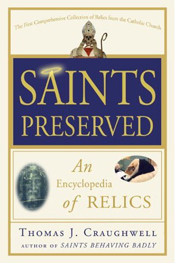
|
 |
Blessed are the body snatchers
Posted on 11 September 2011, 4:49
My lifelong fascination with ‘the far side’ of Christianity easily includes the Catholic Chuch’s love affair with relics, although I must confess some sympathy with it all. It’s a deeply human thing to show respect to what remains of those we’ve loved after they’ve died and the photographs, letters and books of people in my family which have come down to me are beloved things.
So the early Christian practice of meeting at the gravesides of the martyrs and placing their portrait paintings in churches seems absolutely right to me, even though it’s not for everyone. But what about collecting bones and skulls, inspecting the bodies of dead saints and parading their body parts through the streets? Call me squeamish, but it just seems macabre and obsessive, not to mention terminally out of step with modern culture. Believing the Christian faith is hard enough these days without throwing in veneration of the big toe of St Bob the Bizarre.
Back in May this year, a syringeful of John Paul II’s blood, taken from him before he died, was venerated in his beatification mass in Rome, while another found its way to Krakow in Poland. His body has already been moved upstairs from the basement of St Peter’s into the church, and it’s a disturbing possibility that the Vatican’s resurrection men might be visiting his coffin for bits and pieces sometime in the future.
Which is why I was curious to get hold of a copy of a new book, Saints Preserved: An Encyclopedia of Relics, by Thomas J Craughwell. This is a book which knows where the bodies are unburied. If you want to get on a plane to go and venerate one of the many skulls of St George, the Holy Bench Jesus sat on during the Last Supper, the eye of Blessed Edward Oldcorne (don’t ask), the humerus of St Francis Xavier or even the skis of John Paul II, this is where to start.
I’m disappointed though that Craughwell doesn’t pass much critical comment on the history or authenticity of the relics he lists. Many of the saints’ relics are genuine, but all the claimed biblical objects must be regarded as frauds perpetrated on credulous believers.
It’s a fraud the Church has colluded in over the centuries. Take the Holy House of Nazareth, for example, where Jesus, Mary and Joseph lived, which was flown by a team of house-moving angels to Loreto in Italy in the 13th century. A virtual queue of Popes visited the house to bless it and bestow privileges, and only Julius II demurred by adding the words, ‘as is piously believed and reported’ to an account of the shrine’s legend.
However, there are some signs of change, as witnessed by the curious story of the Holy Prepuce (the foreskin of the infant Christ), which was the subject of another book, An Irreverent Curiosity, which I read a few months ago.
According to the book, written by American journalist David Farley, the Holy Prepuce was venerated every January 1st (the feast of the circumcision of Christ) by the people of Calcata, an Italian hill town. This went on for almost four centuries without a problem until 1900, when Pope Leo XIII took the highly unusual step of censoring all mention of the relic on pain of excommunication. The blessed foreskin had become an almighty embarrassment. But then things went further.
In 1983, the priest of Calcata told his congregation that the Holy Prepuce had been stolen from the shoebox in his wardrobe, where he had kept it for safety, and it has never been seen again. Locals believe it was snatched by Church officials to be ‘disappeared’ into the Vatican. Other uncomfortable relics, such as the breast milk of the Virgin Mary, have also been sent into retirement.
Like most traditional elements of Catholicism, the cult of relics has been enjoying something of a revival under John Paul II and Benedict XVI. Their Church has renewed its love of bloodstained shrouds and holy bones. For them, God moves not only in mysterious ways, but in medieval ones too.
Comment (0) |
 |
|
|
 |

|

|
 |
Darkness visible
Posted on 26 August 2011, 5:57
OK, it’s 750 light years away from me, so I’m unlikely ever to encounter it for myself. But there was something to make the blood run slightly colder in last week’s news that a planet orbiting a distant sun is the darkest world ever discovered.
The planet, with the catchy (and French-sounding) name of TrES-2b, only reflects a miserly one per cent of the light that falls on it from its nearby sun. Which means it’s as dark as coal. Close up, it must be hard to see against the blackness of space, and you would only know it was there by the stars it would blot out – which would be rather a lot, given that TrES-2b is the size of Jupiter.
David Spiegel, one of the astronomers to make the discovery, says: ‘It’s not clear what is responsible for making this planet so extraordinarily dark. However, it’s not completely pitch black. It’s so hot that it emits a faint red glow, much like a burning ember or the coils on an electric stove.’
TrES-2b immediately reminded me of one of the stay-with-you episodes in CS Lewis’s Narnia book, The Voyage of the Dawn Treader. In it, the Dawn Treader sails into a darkness in the middle of the open, sunlit sea and finds it a place of terror and madness, where escape again into the light seems impossible.
But it also made me reflect on the opening words of Psalm 19...
The heavens declare the glory of God;
the skies proclaim the work of his hands.
‘Glory’ is a first cousin to the words we use for light, so if the stars of the universe speak of the shining glory of God, then what do the dark objects say about him? The writer of Psalm 19 couldn’t have imagined that the night sky above him contained not just brilliant stars, but also black holes, occult planets and dark matter.
I’m interested in this because Christian theology doesn’t seem to have made much adjustment to the huge amount of new information about the universe that has accumulated in the past century. In the 1920s and 30s, Edwin Hubble and others discovered that the universe doesn’t consist of just our galaxy (as was argued at the time) but countless galaxies – at least 100 billion, according to the Institute of Physics, each containing anything from millions to trillions of stars.
So while it was credible back in the days of Psalm 19 to see the stars as a kind of celestial wallpaper, put there solely for humans to admire and praise the Lord who made them, the vast scale of what is actually out there makes that model look like over-engineering on a cosmic scale. For me, the incredible size of it all and the discovery of objects such as TrES-2b is a severe challenge to the New Testament’s assertion that the human story is critical to the story of the universe as a whole. Our size in the mind-boggling scheme of things is surely too microscopically tiny.
So what does TrES-2b tell us about God? Maybe it speaks of the hidden side of God, the God who ultimately cannot be known, the darkness of God. These themes have been explored by Pseudo-Dionysius the Areopagite and other offbeat theologians, but has its roots back in the early books of the Old Testament. On Mt Sinai, for example, ‘Moses approached the thick darkness where God was.’
So here’s to TrES-2b. A dark and unknowable world reflecting nothing but the darkness and mystery of God.
Comment (3) |
 |
|
|
 |

|

|
 |
Suspicion of online church
Posted on 18 August 2011, 6:47
There’s an interesting conversation happening over on the Big Bible website, where Tim Hutchings is posting good stuff on their blog about online church. Even though the Net has a large number of groups which identify themselves as religious communities, Christians have remained suspicious and wary of them. As Tim says…
‘However sophisticated online churches get, whatever new parts of the Internet they find to grow in, they still make Christians REALLY uncomfortable. If you’re a Christian, and you’re writing a book about the Internet, you’ll almost certainly end up throwing in a grumble about online churches. Online-church-bashing has become one of the most predictable and unimaginative clichés of Christian writing about technology.’
I’ve been thinking about the ironies of this situation for a while, partly because the few Christian conferences I’ve been to in the past year have featured speakers warning against the dangers of false identity on the Internet… a warning so past its sell-by date that it could walk straight out of your smelly fridge and put itself in the bin.
So, a couple of things to say on this.
First, it’s somewhat ironic for Christians to be extolling the virtues of physical communities (‘real-life’ churches) and attacking virtual ones. After all, the whole Christian belief system is based on things that are unseen, including God of course. Our faith may be expressed physically, but the heart of it is virtual. In prayer and worship Christians consciously enter the virtual realm, either closing their eyes to block out the physical world, or looking up to where they imagine God and the spiritual realm to be.
Which makes me think that it is slightly ridiculous for Christians to object to online community on the grounds that it is unreal. It is no more unreal than important aspects of my faith.
Second, online communities are often held to higher standards than we expect from offline communities. For example, here is the Pope (who in fairness has given three thoughtful reflections on digital media in as many years) listing the limits of online communication: ‘the one-sidedness of the interaction, the tendency to communicate only some parts of one’s interior world, the risk of constructing a false image of oneself, which can become a form of self-indulgence.’
Those are good points, but they could equally well be made about the face to face relationships of people in the local church. Creating a fake identity, acting in a superficial way or posing as a pious person were not invented by the Internet – Chaucer had a go at those very human vices in The Canterbury Tales. It’s obviously prejudiced to compare the worst of virtual church with the best of physical church.
In reality, online churches can be just as challenging, boring, exciting and revealing as the church round the corner from you. I don’t see how it could be any other way, since real people, body and soul, make both kinds of church happen.
Comment (2) |
 |
|
|
 |

|
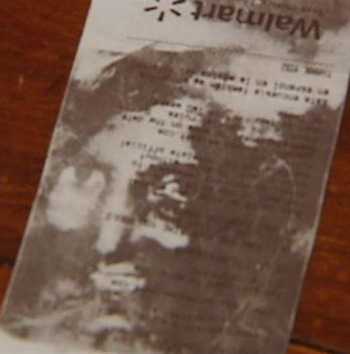
|
 |
Jesus shops at Walmart
Posted on 26 July 2011, 9:07
A South Carolina couple, Jacob and Gentry, went shopping in Walmart for pictures a couple of weeks ago. They found a picture which made headlines around the world, but it wasn’t one of the ones they bought in the store. Because a few days later, as Jacob was walking out of his kitchen, the Walmart receipt, lying on the floor, caught his eye. It had strange, dark markings on it.
‘It was like it was looking at me,’ he said. ‘The more I looked at it, the more it looked like Jesus.’
Stories of Jesus appearing on household objects are two a penny on the Net. It’s a rare month when Our Lord isn’t turning up on a tortilla or a cow’s udder somewhere. Such reports trigger a torrent of comic tweets, as well as punning headlines in newspapers. One appearance of Jesus in a British steak and kidney pie produced an inspired headline in The Sun newspaper: ‘Jesus Crust!’
Curiously, spontaneous images of Christ have a long history. One early legend, dating back to the 6th century or maybe earlier, tells of how Jesus turned down an invitation to pay a visit to the King of Syria. He RSVP-ed by sending the king a cloth he had used to wipe his face. When the king opened it, the face of Jesus was printed on the fabric.
Art historians say legends such as this were developed to provide much needed theological support for the explosive growth in popular images of Jesus, Mary and the saints. Christians of the time were using mass produced holy images in highly superstitious ways, hanging them up in their homes and workshops as good luck charms. Those who championed this popular devotion promoted the legends in a brilliant (and ultimately successful) piece of PR, saying that images were ok because they originated in a miracle of Jesus himself.
With all due respect to Jacob and Gentry, Christians who get excited about God performing a conjuring trick with a Walmart receipt are also perilously close to crossing the line between miracle and magic.
One of the questions always raised by stories such as this is why a stain looking like a man with a beard should always be identified in the media as Jesus? People posting comments on blogs and Twitter over the past week said they saw Charles Manson, Josef Stalin or Rasputin, rather than Jesus. ‘Even a blind person can see that this is Osama Bin Laden,’ said a commenter called gotjapanka on YouTube.
But Christianity has form in this area. Stories of plaster saints which weep and bleed – and even wink or lactate – are still quite common, and although they can also occur in Hinduism, for example, it is the Catholic stories which are strong in Western folk memory.
Even though Christians brought up on Monty Python are able to laugh at reports of Jesus and Mary appearing on a pizza near you, I think many believers are slightly beguiled by the stories almost to the point of wishing they were true. There are good reasons for this.
Firstly, these visitations are invariably tacky. I’m thinking of the toasted cheese sandwich which looked vaguely like the Virgin Mary and which ended up being bought by an online casino for $28,000. And also the Jesus-shaped shadow cast by a tree on a caravan park fence in Australia which caused the person who saw it to exclaim ‘Jesus Christ!’ – and not in a holy way.
These are tales of transcendence meeting trailer park. That is what makes them hugely entertaining, of course, but it also has a certain appeal to Christians, because holy things appearing in humble locations is what the faith of Jesus is all about.
Added to that, the images suggest God is breaking out of organised religion and into the grittiness of everyday life. One comment posted on Huffpost Comedy made a fair point when it said, ‘God appeared to Moses as a burning bush, as a pillar of fire to the Israelites, as an angel to Abraham etc… and we get a Walmart receipt?’
Well, yes… but isn’t that so New Testament? Jesus was born in a barn. So is it any surprise that he shops at Walmart?
If Jesus is going to appear anywhere today, then a pizza shop, supermarket or casino sound exactly right.
However, any Christian tempted to believe that God engages with us today via fuzzy images of a man with a beard should remember some of Jesus’ last words to the first disciples. He told them to go into all the world. It is surely through flesh and blood human beings, rather than stains on checkout receipts, that Jesus touches the earth now.
Comment (0) |
 |
|
|
 |

|
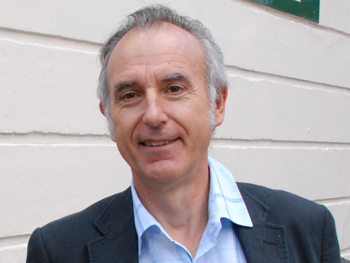
|
 |
Andrew Walker… ahead of the game
Posted on 25 May 2011, 4:32
I spent today at King’s College, London, at a one-day conference in honour of my old friend and partner in crime, Professor Andrew Walker. In the 1990s, Andrew and I jointly edited Leading Light, the journal of the CS Lewis Centre – which was not, I hasten to add, a fan club for Aslan, but an organisation launched by Andrew for studying and promoting ‘gospel and culture’ issues.
Andrew has just retired from King’s and was paid handsome tribute by his friends and colleagues, including Alister McGrath, Pete Ward, Martyn Percy, Luke Bretherton and Billy Abraham.
Martyn Percy focused on Andrew’s book from 1985, Restoring the Kingdom, which gave a brilliant guided tour of the House Church Movement, as it was then known. The book has Andrew’s characteristic blend of journalistic detail (he interviewed many of the big cheeses in the individual House Churches) and penetrating anaysis. He was the son of a Pentecostal household and so he was sympathetic to the movement, but was also only too aware of the history of how revivalism plays out.
I was also fascinated by the paper given by Pete Ward, the author of Liquid Church and Gods Behaving Badly. Part of what he said delved into the relationship between Andrew’s work and that of Lesslie Newbigin, the godfather of the gospel and culture movement. Pete said that in this (and other areas) Andrew was ahead of the game…
While his academic interests neatly coincided with those of Lesslie Newbigin I would argue that Andrew was more attuned to contemporary culture and the social reality of the Church and as a result his work, though less well known, was actually more useful to those who were buying into a missiological vision for the Church…
Andrew was deeply appreciative of Newbigin but it is my sense that he was too much of a sociologist to see philosophy as the arena in which to do battle. In Telling the Story, Andrew showed how theological ideas are situated in communities and communicative practices. He was one of the first to put his finger on the way that religious faith and ecclesial cultures arose from innovations in media.
Andrew has written and edited a large number of books. One of his great gifts is his enthusiasm in bringing people together to work on projects, and so his multi-author books are really worth reading alongside his solo works. Here’s my recommended Walker booklist…
Restoring the Kingdom (1985)
Different Gospels (1998)
Telling the Story (1996)
Living Orthodoxy (1996)
Remembering our Future (2007)
Comment (0) |
 |
|
|
 |

|

|
 |
Confessions of a red-hot Mac believer
Posted on 14 May 2011, 19:42
I’m talking about the cult of Apple in London next Wednesday, 18 May, so as an appetiser, here’s my Mac testimony.
When I bought my first Mac (the Macintosh SE, with its colossal 20Mb hard disk and 9 inch black and white screen) in 1988, it felt like coming to Jesus all over again. I’d spent the past year working with Macs in the design agency where I was at the time, but now at last I was making my own personal decision, asking Steve Jobs to change my life, becoming part of the Apple Family.
Like every disciple, I knew I would need to renounce the Devil (Bill Gates) and all his works (Microsoft and the PC), and become a fervent Mac evangelist. Even today, 23 years later, I still have a devout hatred for PCs and their clunky interfaces, and a zealous desire to witness to others about the blessings of Mac.
Although I’m naturally thrilled about the missionary success of Apple, which has seen it lay claim to the whole of our technological lives, with phones, music players and tablets headlining an impressive product list, in my heart I still yearn for those early days when I was one of the chosen few. When I was a red-hot Mac believer. How blessed was I to wake up each morning to the joyous startup chimes and the Happy Mac icon!
If Apple is a religion, what kind of religion is it? Umberto Eco whimsically remarked in 1994 that ‘the world is divided between users of the Macintosh computer and users of MS-DOS compatible computers… I am firmly of the opinion that the Macintosh is Catholic and that DOS is Protestant.’
And it’s true that Steve Jobs is a good stand-in for the Pope, dressed in black turtleneck rather than white robes, but issuing Encyclicals and Bulls in the absolutist Roman style. But when I think about the cult of Apple, it’s more complex than Catholicism. It’s a faith that’s as preachy as Billy Graham. As ascetic as the Desert Fathers and Mothers. As hooked on miracles and spectacle as Benny Hinn. As Manichean as… er… the Manichees. And as smug as Alpha.
I’m going to be exploring all this next Wednesday, 18 May at 7.30pm, at Apple on Apple, the 11th Apple forum hosted and run by Kester Brewin. Just come along, grab a pint and some food and join in the discussion upstairs at The Betsey Trotwood, 56 Farringdon Road, London EC1R 3BL, close to Farringdon station.
There will naturally be an Apple Mac relic at the event, for veneration by the faithful.
Photo: Danamania
Comment (4) |
 |
|
|
 |

|
Qur’an: three brother faiths
Posted on 28 October 2010, 5:51
Why I’m reading the Qur’an
Qur’an sura 2
In the weeks since I decided to start reading Islam’s holy book, I’ve been slow to make progress. It’s partly because the opening suras (chapters) are the longest and look more daunting than the smaller ones at the back – but at least I’m now deep into sura 2, which is entitled The Cow.
One of the trivial things I like very much about the Qur’an is the chapter titles, which are short and inviting. Casting an eye down the contents page, I’m intrigued by The Spider, Smoke, Rolling Sands and Enfolded, all of them titles, and find myself looking forward to reading them.
The Cow has been heavy going, though, with a great deal of talk about blasphemers and unbelievers and the horrible fate which awaits them. At first I was overwhelmed by the violent storminess of these negative verses, until I began to find my sea legs. That happened when I started to notice a nuanced attitude to Christians and Jews. Some passages are very generous, for example…
As for the believers, for the Jews, the Christians and the Sabeans who believe in God and the Last Day, and who do righteous deeds – these have their wages with their Lord. No fear shall fall upon them, not shall they grieve (sura 2:62).
Other passages offer strongly worded criticism of the other faiths’ refusal to accept Muhammad as the promised prophet of God. In this next quote, for example, the writer sketches the story of the Jewish prophets in a sentence, beginning with Moses and ending with Jesus (who is called ‘son of Mary’ as a way of stressing his humanity and denying his divinity)...
We revealed the Book to Moses, and We sent after him messengers in succession; and We granted Jesus son of Mary evident miracles and strengthened him with the Holy Spirit… (sura 2:87).
But when Muhammad came – the passage continues – preaching a message which confirmed what the Jewish people had already received, they refused to accept it. Why? Because Muhammad was not one of them. To my eyes, these verses are full of hurt as well as anger – the hurt of unfair rejection. They remind me of the hurt and irony expressed in John’s Gospel about the coming of Jesus: ‘He came to that which was his own, but his own did not receive him’ (John 1:11).
Because of the chronology, the New Testament has to talk about the Jewish people and how it sees them. And the Qur’an, which comes even later than the New Testament, has to talk about both the Jews and the Christians. As the youngest brother of the three faiths, it is very aware of them both: loving these older siblings for what it has received from them; hating them for where they have gone astray. It’s very much a family thing, in the Middle Eastern way.
Quotes are from the 2008 translation of The Qur’an by Tarif Khalidi, published by Penguin.
Comment (1) |
 |
|
|
 |

|
Qur’an: the opening
Posted on 22 September 2010, 5:17
Why I’m reading the Qur’an
Qur’an sura 1
Where the Bible opens by showing us God already in action, hard at work creating heaven and earth, the short opening sura of the Qur’an is in no such hurry. Impressively, its calm attention is on the God who is, rather than the God who does. And it begins by inviting me, the reader, to offer my proper human response to God…
Praise be to God, Lord of the Worlds:
Merciful to all,
Compassionate to each!
The language immediately reminds me of the Psalms and makes me wonder if the Bible would be different if it began, say, with Psalm 23. I think it would set a different emotional tone, and that’s the feeling I get reading these much-loved opening words in the Qur’an. Also impressive is this first glimpse of the qualities of God: ‘Lord of the Worlds’ sounds grand but distant, while mercy and compassion speak of love and presence.
After these three lines, the Qur’an turns to address God directly as ‘Lord of the Day of Judgement’. The writer calls for God’s help in following the straight path, which is full of God’s generous grace, rather than joining the lost, who know only God’s anger.
In Psalm 1, the poet contrasts two roads: the way of the righteous and the way of the wicked. Jesus refines the idea with his image of the broad way which leads to destruction and the narrow way which leads to life. But here in the Qur’an there seems to be just one road blessed by God; the alternative is to be lost in the desert, with no road to follow.
The three monotheistic faiths envisage a right way and a wrong way. You are righteous or you are wicked. You follow God’s will or you are lost. You are welcomed with grace or driven out with anger. That uncompromising view is challenged now in western culture by the belief that there are many paths in life, and we have the freedom to choose between them without being judged. This sura raises the issue for me with new clarity.
Ziauddin Sardar, who blogged the Qur’an in 2008, says that these opening lines are known as ‘the mother of the book’, in that they sum up the essence of the Qur’an, as well as being woven into the prayers which Muslims make five times a day.
If holy places are bathed in glory because of all the prayer that has been offered in them, then that must be true of these words, in which so much love, passion and hope has been placed.
Comment (0) |
 |
|
|
 |

|
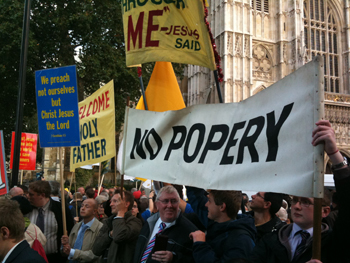
|
 |
A Roman triumph in London
Posted on 20 September 2010, 8:29
Standing on sunny Lambeth Bridge on Friday, waiting for the Pope to emerge from Lambeth Palace and his meeting with the bishops and archbishops of the Church of England, I found myself next to Sister Veronica, a little nun from Cornwall with sky-blue eyes and a smile as wide as the ocean, who was waving a jolly big, yellow papal flag.
Everyone loved her: people kept coming over to ask if they could take her picture, for which she happily stood, and the policemen lining the barricades also stepped forward every now and then to ask if she was ok? Sister V, who has worked with young people for many years, had been on the bridge for five hours and was determined not to miss the Pope as he went by on his way to Westminster.
A mini-bus sped past us and she waved her papal flag at it. ‘I’ll wave at anything now,’ she said, laughing, ‘but those really were cardinals – I could see their red sashes round their waists.’
Behind us, Big Ben struck 5 o’clock, the time when the Popemobile was due to cross the bridge. I’d been tweeting events from my viewpoint all afternoon, and so hit the send button on the following: ‘Big Ben strikes 5… time for the Pope to finish up his tea, get into Ice Cream One and come over to Westminster.’
A policeman wandered over and said to Sister V: ‘He’ll be here in a couple of minutes.’
‘How do you know?’ I asked.
The policeman turned a perfectly straight face to me: ‘I can’t reveal my sources.’
Seven minutes later, the Popemobile swung onto the far end of Lambeth Bridge looking exactly as someone described it on Twitter a few days ago: ‘a bulletproof ice cream van’. It was surrounded by fridge-shaped men in well-cut dark suits who furiously eyeballed faces in the crowd as they walked the Popemobile along.
Above them, the Pope was imprisoned inside a greeny-blue bubble, sitting on a white plastic throne and waving in an old-man kind of way to the crowds on either side. So thick is the Popemobile’s armoured glass that he looked more like a hologram than the real thing, but one glance at the Vatican’s grim security detail told you this was the one and only Pope of Rome.
Sister Veronica hopped up onto a granite ledge behind me to get a better view, and as the Popemobile drew level with me on the crown of the bridge, I gained eye contact for the splittest of split seconds with Joseph Ratzinger as his pale blue eyes passed over me. I hope he did the same for Sister V, who was much more deserving of his attention.
The streets were stiff with crowds trying to slipstream behind the Holy Vehicle, but I found a back way, grabbed a coffee to drink as I walked, and came out by Great Smith Street, right in front of the west door of Westminster Abbey.
Coming towards me through the crowd was a highly pumped-up black preacher of the ranting school, blasting a way through the tightly-packed people by the sheer force of his shouted sermon. He was wearing a glossy barbecue apron printed with a Bible text. I tried to talk to him, but he ignored me and launched tunelessly into the evangelical chorus, ‘I love my Jesus, my Jesus loves me.’
The Popemobile pulled up outside the Abbey, and a forest of arms sprouted from the crowd, each hand holding a camera, wildly pointing and clicking in search of a Pope shot, however blurred. Once he was inside the Abbey and evening prayer had started, I looked around at the banners jostling for attention.
There was a huge sign reading ‘Welcome Holy Father’, and another with the less snappy, but still papal-friendly, ‘On this rock I will build my Church’.
More unpredictable was ‘We [heart] you Papa more than beans on toast’ held aloft by Niamh, a Catholic youth worker from North London. She was also wearing yellow and white papal wellington boots she had specially made, which I’m sure the Pope might like to swap for his red slippers.
Right next to ‘Welcome Holy Father’ was a black and white banner which sternly demanded, ‘No Popery’. And surrounding it, an armada of smaller banners made by old school Protestants, who were there in force. A couple of burly men from their team, sporting ‘Exalt Christ not the Pope’ t-shirts, told me they were from Zion Baptist in Glasgow, a Calvinistic church which has picketed Marilyn Manson in the past, and has followed the Pope down to London for this protest.
There were times in the next hour when I thought fighting might break out as Catholic and Protestant banners jockeyed for position in front of the TV cameras.
I talked to a Catholic woman carrying a huge picture of Benedict XVI and she was angry and upset. Her lovely day out with Papa Benny was being spoiled. ‘There are stupid people here shouting out that the Pope is a pedophile,’ she told me.
The streets of London have never sounded more theological. I passed one man explaining the teaching of St Irenaeus of Lyons to a small group of listeners. And further along, while rough-looking men hawked Pope badges to passers-by (‘Only a quid, mate’), a tall Catholic was in passionate conversation with a short Protestant about Matthew chapter 16, each man jabbing a finger at the other.
And all the while, as dusk fell, the Abbey stood huge, silent and pregnant with the people, priests, bishops, archbishops, cardinals, the Pope and the hard men of Vatican security inside. I was following the service on Twitter and was able to read the Pope’s address. With typical Ratzinger pugnacity he asserted his primacy as the successor of St Peter and reminded his listeners that the ancient building once belonged to Rome.
We waited. It grew dark. The banners manoeuvred. The arguments raged. Grown men in plastic aprons shouted themselves hoarse for the Lord.
Then the west doors swung open and the Abbey bells rang out, like the most joyous wedding, and the crowd went up in a rapture. In fact, it felt so like a wedding that I half expected to see that odd couple, Rowan Williams and Joe Ratzinger, walk out hand in hand surrounded by clergy bridesmaids in lacy frocks… but that’s another universe.
In short order, the Pope entered a dark car and his motorcade swept from the Abbey. I couldn’t help noticing that the last vehicle was an ambulance. It was a Roman triumph, with mortality whispering in the ear.
Comment (1) |
 |
|
|
 |

|
Holy Communion… in six tweets
Posted on 07 September 2010, 1:36
My piece about online communion has just been published on Ship of Fools. A shorter version was published in the Church Times a couple of weeks ago, and is now available on the Church Times website.
Revd Tim Ross, whose idea for a Twitter communion service sparked the whole thing off, gave me permission (thanks, Tim) to put his Twitter liturgy online, so here it is. The service was to be delivered in six tweets, and I assume there was to be a short gap of a few minutes between each tweet.
Father of us all, your people round the world join together in praising you. God of wonder, we marvel at your grace, power and love.
From the depths of loving grace you gave us Jesus, your Son, our Saviour. Dying, he brought us forgiveness. Rising, he brings us new life.
In this simple meal, we remember what Jesus shared with his followers and all that you share with us now in his name.
Fill us with your Spirit and through his power, bless these gifts of bread and wine to us.
The body of Christ was given for you. (Take bread) The blood of Christ was shed for you. (Take wine)
Thank you that you are our Manna and our Daily Bread. May our food be doing your will and your joy our source of strength.
Comment (0) |
 |
|
|
 |

|
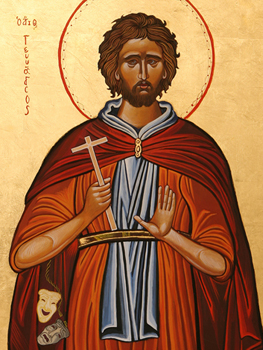
|
 |
Heaven’s comedian
Posted on 26 August 2010, 4:47
I hadn’t heard of him before today, and alongside St Simeon the Holy Fool (who is the patron saint of Ship of Fools), I think St Genesius the Comedian is a good addition to the house of unlikely saints. His martyrdom is related in the medieval Acts of the Saints and it’s highly likely to be pure legend, but it’s an interesting story, nevertheless.
The story of Genesius is set in the time of the Roman Emperor Diocletian, who was behind the most severe of all the persecutions of Christians at the beginning of the 4th century AD. Genesius was the leader of a theatrical troupe, and hearing that the emperor was coming to town, prepared a comic satire against the Christians for his entertainment.
In the comedy, actors playing the part of a priest and an exorcist came to mock-baptise Genesius, but as he was washed with water, he had a vision. He saw a company of angels who read out his sins from a book, and then washed the book clean, turning his stage baptism into a real one. Genesius was converted on the spot and when he began to preach to the audience, the emperor, who had been laughing at the comedy, became enraged. Genesius was beaten and then killed.
The early church was mostly hostile to the theatre and circuses, and the story of Genesius can be seen as an attack on the theatre; but in a curious way it’s redemptive, suggesting that even the mockery of faith can lead to the discovery of faith. St Genesius remains an important spiritual champion for actors, and one set of prayers I found today calls him ‘heaven’s comedian’. The modern icon shown above has the masks of comedy and tragedy tucked inside his cloak.
Here’s a good article which includes a version of his story.
Comment (0) |
 |
|
|
 |

|

|
 |
Communion on Twitter
Posted on 20 August 2010, 0:17
Writing my piece for the Church Times about the cancelled Twitter Communion, I talked with Rev Tim Ross (pictured above) on the phone about his thinking behind the project.
One of the questions I asked was whether Twitter was an appropriate medium for communion, which for me has always been a very reflective experience, while Twitter can be pretty noisy and fast-paced. I notice that Tim is currently following 1,945 people, which must make his feed quite busy.
He said, ‘I find Twitter quite intimate, as many people have asked for prayer in response to what I’ve been posting.’ His posts to date have been a mix of the Lord’s Prayer in contemporary language, individual prayers, and a service of prayer for Christian unity and vision.
Tim told me he especially likes the SMS-like brevity of tweets, the instantaneous nature of Twitter and the around-the-globe audience you reach whenever you click the Tweet button. These qualities gave him the idea for attempting his communion service.
‘We have to be careful about making communion too parochial,’ he said. ‘If we think it can only be expressed in a local body, that narrows our horizons. The teaching of Paul, that we are all one body, is about a deeper connectivity that goes around the world. The community of saints is bigger and broader than our geographical constraints.’
When I pointed out that the sense of community on Twitter is bound to be greatly diluted when compared to the average local church, he responded, ‘You can take communion alongside people all the time in a local church without knowing who they are.’
That observation really does ring a bell for me. One constant I’ve noticed over the years of talking about online religion is that the opponents of virtual church demand much higher standards of community than you will ever find in a local congregation.
Comment (2) |
 |
|
|
 |

|
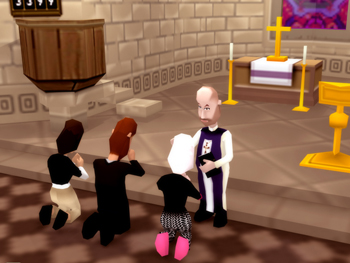
|
 |
Pixellated bread, tweeted wine
Posted on 06 August 2010, 19:39
Last week, a Twitter communion service scheduled for 14 August was called off after the UK Methodist Church pulled the virtual plug. The service was the brainchild of Rev Tim Ross, a Methodist minister, and as far as I know would have been a first for Twitter.
Tim explained on his Twitter Communion website: ‘Whilst I have not been absolutely forbidden to perform the Communion on Twitter, British Methodist Church authorities have strongly urged me to cancel it. The main reason for this, they say, is that it comes at difficult time, because the whole issue of performing services like Twitter Communion over the Internet is being re-examined by the Methodist Church.’
I’m writing a piece for the Church Times about virtual communion: mad, bad or fab? And including the current state of play on the subject in some of the online churches, including St Pixels, i-church and the Anglican Cathedral of Second Life. I’m collecting material for that over the next few days, so if you have a story to tell about online communion or virtual worship, or want to say what you think about the pros and cons, please comment below.
When we launched Church of Fools in 2004, we did think about installing a pool baptistery (as we’d already made a virtual swimming pool for The Ark), but decided we’d have enough to worry about in just doing 3D church – which proved to be right. Church of Fools was partly sponsored by the Methodist Church, so I’m especially interested to hear that they’re now making cautious noises about online worship.
Picture: Church of Fools publicity shot
Comment (21) |
 |
|
|
 |

|
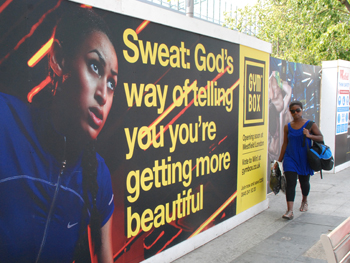
|
 |
Street theology
Posted on 28 June 2010, 15:17
Seen outside Westfield, Shepherd’s Bush, where a new gym is about to open. The statement seems a bit optimistic, but nice to see some theology from the Hallmark Cards school happening on the street.
Comment (0) |
 |
|
|
 |
|
|
|
